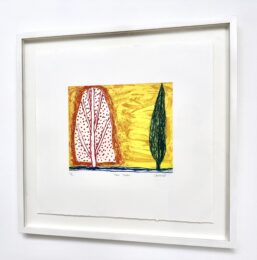


1930 - 2011
William Crozier was an Irish-Scots still-life and landscape artist based in Hampshire, England and West Cork in Ireland.
Irish parents gave birth to Crozier in Glasgow, where he received his education from 1949 to 1953 at the Glasgow School of Art. After receiving his degree, he briefly lived in Paris and Dublin before relocating to London. Thanks to the early success and notoriety of his exhibitions of assemblages and paintings at the ICA, Drian, and the Arthur Tooth galleries, with whom he had a long association, he came to be known as the 1950s equivalent of a Young British Artist.
In the 1950s and 1960s, Crozier, deeply influenced by post-war existential philosophy, deliberately aligned himself and his work with contemporary European art rather than with the New York abstractionists, who were more popular in the UK at the time. He was also a part of the literary and artistic community in Soho in the 1950s, a close friend of “the Roberts,” Colquhoun and MacBryde, John Minton, and William Scott, and a member of the era’s middle-European and Irish expatriate intellectual communities in London. The time that Crozier spent in southern Spain in 1963 with the Irish poet Anthony Cronin was crucial to his growth as an artist. Upon his return to the UK, he started a series of skeletal paintings that were motivated by Crozier’s visit to Auschwitz and Belsen in 1969 and foreshadowed the ‘New Expressionist’ German painters of the 1980s.
Crozier, who resided in London during the 1960s and 1970s, displayed his artwork throughout Europe, including in Glasgow, Dublin, and London. Crozier, like many other artists of the 1960s, combined teaching and painting, first at Bath Academy of Art (where he worked with Howard Hodgkin, Gillian Ayres, and Terry Frost), then at the Central School of Art and Design (where he worked with William Turnbull and Cecil Collins), at the Studio School in New York, and finally at Winchester School of Art, where he oversaw a potent painting department rooted in the European tradition. After Crozier stopped teaching in the 1980s, his painting flourished with a new freedom and assurance thanks to the inspiration from his studios in Hampshire, England, and West Cork, Ireland. His abstract landscapes and still life paintings employed lavish colour to evoke an intensity of emotion. He never stopped worrying about the difficulty of developing a new vocabulary for figurative painting until the very end of his life.
William Crozier received the Premio Lissone in Milan in 1958 and the Oireachtas Gold medal for Painting in Dublin in 1994 as a representative of the UK and Ireland abroad. His work was the subject of a retrospective in 1991 organised by the Crawford Art Gallery in Cork and the Royal Hibernian Academy. In addition to being elected an honorary member of the Royal Hibernian Academy, he was elected to Aosdana in 1992. In honour of Cork’s designation as the European Capital of Culture, Crozier celebrated his 75th birthday in 2005 with a significant exhibition. Here, Crozier displayed several of his drawings, giving viewers their first glimpse of the innovative black-and-white artist behind the master of colour. While a parallel exhibition of his paintings from the 1950s and 1960s at the Pyms Gallery, also in London, led to a reevaluation of his early painting, he marked his 80th year with a sizable exhibition of his current work there. The Tate Gallery and the National Gallery of Ireland swiftly acquired his works.